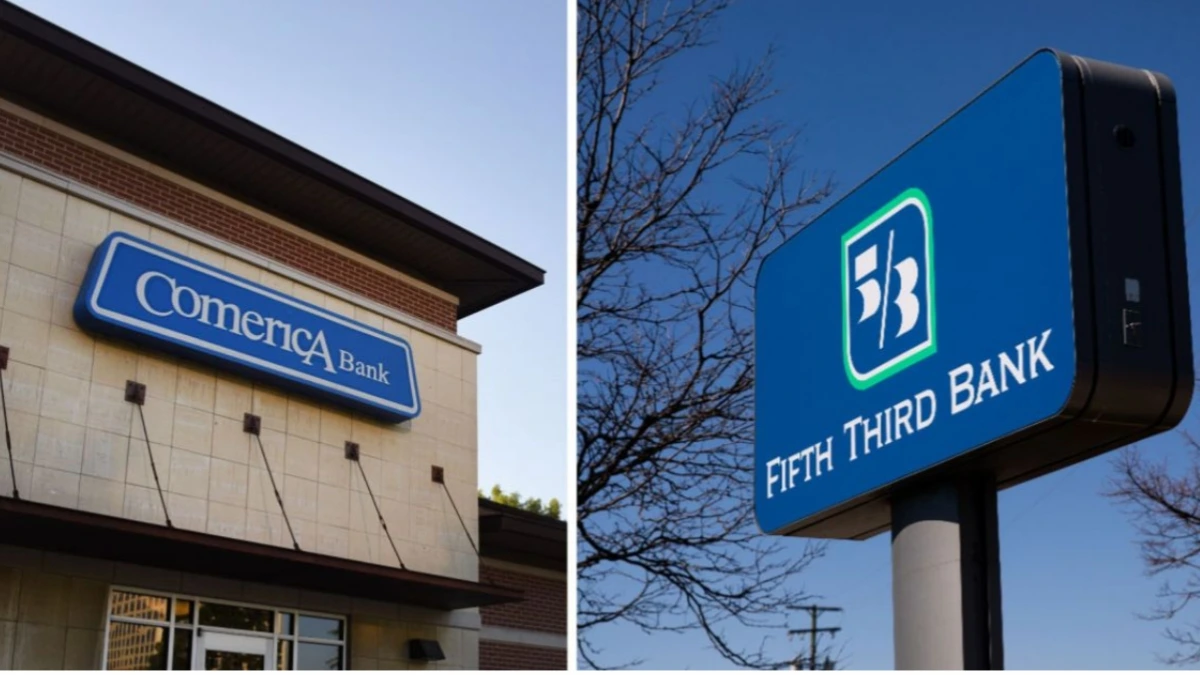CINCINNATI — In a major move signaling continued consolidation among regional lenders, Fifth Third Bancorp announced Monday it will acquire Comerica Inc. in an all stock deal valued at $10.9 billion.
The Fifth Third Comerica deal will create the ninth largest US bank, with combined assets of approximately $288 billion, expanding the institution’s footprint across key growth markets.
The merger is expected to close in the first quarter of 2026, pending regulatory and shareholder approval.
This combination marks a pivotal moment for Fifth Third as we accelerate our strategy to build density in high-growth markets and deepen our commercial capabilities, Fifth Third CEO Tim Spence said in a statement.
Shares of Comerica rose 11.5% in premarket trading after the announcement, while Fifth Third shares slipped about 3%, reflecting investor caution over integration challenges.
The Fifth Third Comerica deal is among the largest regional bank mergers in recent years, coming amid rising costs, evolving customer expectations, and tighter regulatory requirements.
Both Cincinnati based Fifth Third and Dallas based Comerica have deep roots in commercial banking, small business lending, and wealth management.
Founded in 1858, Fifth Third has steadily expanded beyond its Midwest base into the Southeast. Comerica, established in 1849, operates across Texas, California, and Michigan.
By combining their complementary geographies, the merged bank aims to gain scale, improve efficiency, and enhance competitiveness against larger national players.
The deal echoes previous regional consolidations such as PNC’s $11.6 billion acquisition of BBVA USA in 2021, signaling a continued wave of mergers designed to strengthen balance sheets and digital infrastructure.
Banking analysts said the Fifth Third Comerica deal reflects a growing industry trend toward scale and diversification.
Mid sized banks are finding that scale is essential in today’s environment, said Erica Noland, a banking analyst at MorningView Research. “Mergers like this allow them to spread out technology costs, meet regulatory demands, and expand their product lines.”
Noland added that the combined entity will have stronger commercial lending capacity and a broader deposit base, which could enhance profitability.
> “The key test will be integration,” she said. “Aligning systems, cultures, and regional strategies can be complex.”
Economists also noted potential cost savings and synergies, though they cautioned about workforce reductions and overlapping operations.
“While these deals often create long term efficiency, they can initially bring job uncertainty and branch closures,” said Dr. Harold Kim, finance professor at Southern Methodist University. “Still, the end result is typically a stronger, more resilient institution.”
Under the terms of the transaction, Comerica shareholders will receive 1.2 shares of Fifth Third common stock for each Comerica share. The price represents a 15% premium over Comerica’s recent closing value.
The merged bank will serve 12 million customers across 20 states, operate more than 1,200 branches, and manage roughly:
$288 billion in total assets
$210 billion in deposits
$180 billion in loans
US Bancorp holds around $682 billion in assets, Truist Financial has $565 billion, PNC Financial stands at $558 billion.
The combined Fifth Third Comerica bank would surpass other regional peers like Regions Financial and KeyCorp, reinforcing its standing among the top ten US banks.
Reaction among customers and employees was mixed, balancing optimism with caution. “I’ve been a Comerica customer for years,” said Linda Martinez, who runs a small business in Dallas.
“If this merger means better digital banking and access to more credit, I’m hopeful. But I’m also concerned about how it might affect local branches.”
Employees expressed uncertainty over future roles as integration plans unfold. There’s always anxiety when banks merge, said a Fifth Third branch manager in Michigan who asked not to be named.
We’re waiting to see how leadership handles overlapping markets. Community leaders voiced cautious optimism, pointing to potential investments and broader economic impact.
A larger, more diversified bank can bring new capital to regional projects, said Marcus Allen, director of the Midwest Chamber of Commerce. “As long as they maintain local commitments, this could be positive for our economy.”
Fifth Third said the Fifth Third Comerica deal will accelerate its strategic expansion into high growth regions like Texas, Florida, and the Carolinas, while bolstering its commercial and consumer banking divisions.
The combined company will maintain dual operational hubs in Cincinnati and Dallas, though filings list Cincinnati as the primary headquarters. Comerica’s CEO Curt Farmer will join the merged company’s board.
“Together, we’ll build a stronger institution with deeper client relationships and broader capabilities, Farmer said in a joint statement.
Analysts expect more regional bank mergers ahead, especially as institutions face competitive pressures from fintechs, larger banks, and rising operational costs.
“This is unlikely to be the last major merger we see,” said Mary Chou, partner at Everett Consulting Group. “Scale and adaptability are now survival tools for regional banks.”
The Fifth Third Comerica deal marks a pivotal step in reshaping America’s regional banking landscape. By combining two historic institutions with complementary strengths, the merger aims to deliver greater scale, improved efficiency, and expanded services in key growth markets.
Pending regulatory approval, the transaction is set to close in early 2026. As the banking sector continues to consolidate, the Fifth Third Comerica merger reflects a broader shift toward size, stability, and strategic positioning in an increasingly competitive industry.

